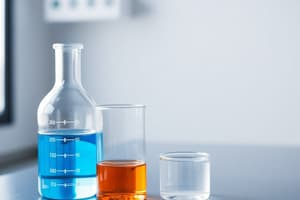Podcast
Questions and Answers
What are colligative properties in chemistry?
What are colligative properties in chemistry?
- Properties that remain constant regardless of the solute concentration
- Properties that only change with the volume of the solvent
- Properties that are unrelated to the boiling or freezing point of a solution
- Physical properties that depend on the concentration of a solute in a solution (correct)
How is concentration commonly measured in solutions?
How is concentration commonly measured in solutions?
- Molarity (moles per liter) (correct)
- Liters per mole (L/mol)
- Moles per gram (mol/g)
- Grams per liter (g/L)
What happens to the vapor pressure of a solvent when a non-volatile solute is added?
What happens to the vapor pressure of a solvent when a non-volatile solute is added?
- Becomes zero
- Decreases (correct)
- Remains unchanged
- Increases
What is the relationship between molarity and solution concentration?
What is the relationship between molarity and solution concentration?
What is molality defined as?
What is molality defined as?
Which statement about solutes dissolving in solvents is true?
Which statement about solutes dissolving in solvents is true?
How can the concentration of a solution be increased?
How can the concentration of a solution be increased?
What are colligative properties useful for?
What are colligative properties useful for?
What is the solute in an aqueous solution?
What is the solute in an aqueous solution?
Which component of a solution is present in a greater amount in an aqueous solution?
Which component of a solution is present in a greater amount in an aqueous solution?
What does molarity measure in a solution?
What does molarity measure in a solution?
In the formula for molarity, what does the numerator represent?
In the formula for molarity, what does the numerator represent?
What does solubility refer to in a solution?
What does solubility refer to in a solution?
Which expression describes the mass of the solute per mass of the solution?
Which expression describes the mass of the solute per mass of the solution?
In which situation is molality particularly useful?
In which situation is molality particularly useful?
What is molarity based on?
What is molarity based on?
Which expression is independent of the mass or volume of the solution?
Which expression is independent of the mass or volume of the solution?
Why is mole fraction particularly useful when dealing with solutions containing volatile components?
Why is mole fraction particularly useful when dealing with solutions containing volatile components?
Flashcards are hidden until you start studying
Study Notes
Chemistry Solutions: Exploring Colligative Properties, Concentration, and Solutes
Solving the mysteries of chemistry often means delving into the world of chemical mixes, or solutions. In this article, we're going to dissect solutions by focusing on colligative properties, concentration, and solutes — the fundamental concepts that underpin the behavior of solutions in chemistry.
Colligative Properties
Colligative properties are physical properties that depend on the concentration of a solute in a solution. Four common colligative properties are boiling point elevation, freezing point depression, osmotic pressure, and vapor pressure lowering. These properties change in a predictable, linear way as the concentration of a solute increases.
For example, when a non-volatile solute is dissolved in a solvent, the vapor pressure of the solvent decreases, resulting in a lower boiling point for the solution. This is known as boiling point elevation.
Solution Concentration
Concentration is the amount of solute per unit volume or mass of solution. The most common units for concentration are moles per liter (mol/L), or percent by mass (w/w) and volume (v/v).
One way to measure concentration is by using a solution's molarity, which is defined as the number of moles of solute per liter of solution. Molarity is a useful unit for comparing the concentration of solutions of different solutes or the same solute in different solvents.
Another way to measure concentration is by using a solution's molality, which is defined as the number of moles of solute per kilogram of solvent. Molality is a useful unit when comparing solutions with different solvents but similar solutes or when the concentration of the solution does not vary with temperature.
Solutes and Solvents
A solute is a substance that dissolves in a solvent, forming a solution. The solvent is the substance in which the solute dissolves and is in the greater amount in the solution.
The behavior of solutes in a solution can vary significantly. Some solutes, like salt, dissolve completely in water, while others, like oil, do not dissolve at all. The solubility of a solute depends on the attractive forces between solute and solvent molecules, as well as the temperature and pressure of the system.
The concentration of a solution can be increased by adding more solute, diluted by adding more solvent, or both. The properties of the solution, such as boiling and freezing points, will change based on the concentration of the solute.
Applications and Future Possibilities
Colligative properties and solution concentration have countless applications in everyday life and science. For instance, antifreeze is used in cars to lower the freezing point of water in the engine's cooling system, preventing the water from solidifying and causing engine damage during cold weather.
In the future, Bing Chat may allow users to instruct it not to search the web for an answer, a feature known as "No Search," which will be especially useful when solving complex math problems, coding, or just having casual conversations.
This article has explored the fundamentals of chemistry solutions, focusing on colligative properties, solution concentration, and solutes. By understanding these concepts, you'll be better equipped to delve into the fascinating world of solutions in chemistry, whether through hands-on experiments or exploring the latest research.
Studying That Suits You
Use AI to generate personalized quizzes and flashcards to suit your learning preferences.




